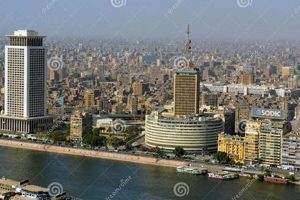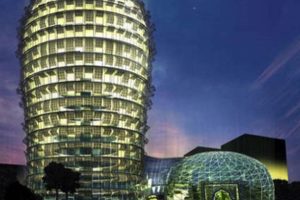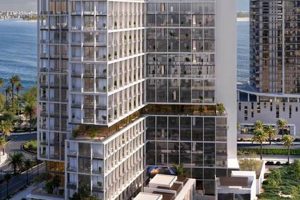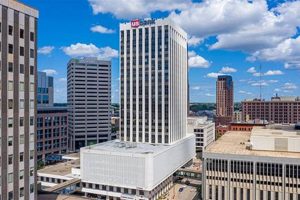Skyscraper graffiti refers to the artistic expression and intricate designs created on the exteriors of tall buildings. It involves scaling great heights and utilizing various techniques like painting, stencils, and projections to leave a mark on the urban landscape.
The significance of skyscraper graffiti lies in its ability to transform the appearance of cities, challenge societal norms, and provide a platform for marginalized voices. Historically, it has been used as a means of protest and activism, with artists using the facades of skyscrapers as canvases to convey powerful messages.
In recent years, skyscraper graffiti has evolved into a recognized art form, with artists gaining wider recognition and even collaborating with building owners to create visually stunning and thought-provoking works. Its impact extends beyond aesthetics, as it stimulates conversations about urban aesthetics, freedom of expression, and the role of art in public spaces.
1. Vertical Canvas
The vertical canvas of skyscrapers offers artists a unique and awe-inspiring platform for their creations. The sheer height and scale of these structures allow for monumental artworks that command attention and become landmarks in their own right. By embracing the verticality of skyscrapers, artists can create visually striking works that are both captivating and thought-provoking.
One of the key advantages of using skyscrapers as a canvas is the ability to create works that are visible from great distances. This allows artists to reach a wider audience and make a more significant impact with their art. Additionally, the height of skyscrapers provides artists with a unique perspective on the urban environment, allowing them to create works that offer new and unexpected vantage points.
In recent years, there has been a growing trend of artists collaborating with building owners and architects to create site-specific works that are tailored to the unique features of each skyscraper. These collaborations have resulted in some of the most innovative and groundbreaking examples of skyscraper graffiti, pushing the boundaries of what is possible in this art form.
The vertical canvas of skyscrapers is a powerful tool that allows artists to create visually striking and thought-provoking works of art. By embracing the height and scale of these structures, artists can reach a wider audience and make a more significant impact with their art.
2. Urban Transformation
Skyscraper graffiti has a profound impact on urban transformation, reshaping the visual landscape of cities and adding vibrant and thought-provoking elements to the urban environment. The towering heights and expansive surfaces of skyscrapers provide artists with a unique canvas to create works that are both visually striking and conceptually challenging.
One of the most significant ways that skyscraper graffiti transforms the cityscape is by adding color and vibrancy to often monotonous urban environments. The bright colors and bold designs of graffiti can breathe new life into tired and neglected areas, creating a more visually stimulating and engaging experience for residents and visitors alike.
Beyond its aesthetic impact, skyscraper graffiti also plays an important role in challenging societal norms and provoking thought. By placing their work on such visible and prominent structures, artists can use skyscraper graffiti to communicate powerful messages about social and political issues, raise awareness for important causes, and inspire viewers to think critically about the world around them.
The practical significance of understanding the connection between skyscraper graffiti and urban transformation lies in the potential for this art form to be used as a tool for positive change in cities. By working with artists and community groups, city planners and urban designers can harness the power of skyscraper graffiti to create more vibrant, inclusive, and thought-provoking urban environments.
3. Artistic Expression
Skyscraper graffiti provides a unique platform for artistic expression, allowing artists to showcase their creativity and challenge artistic boundaries in unprecedented ways. The towering heights and expansive surfaces of skyscrapers offer artists a vast canvas to experiment with new techniques, push the limits of scale, and create works that are both visually striking and conceptually challenging.
One of the most significant ways that skyscraper graffiti enables artistic expression is by providing artists with a highly visible and impactful platform. By placing their work on such prominent structures, artists can reach a wider audience and make a more significant impact with their art. This visibility can help artists to gain recognition, build their careers, and inspire other artists to push the boundaries of what is possible in graffiti and street art.
Beyond its practical benefits, skyscraper graffiti also plays an important role in challenging artistic boundaries and conventions. By working on such a large scale and in such a public forum, artists can experiment with new techniques, materials, and approaches that would not be possible in more traditional settings. This experimentation has led to the development of new artistic styles and techniques, and has helped to push the boundaries of what is considered to be “art.”
The practical significance of understanding the connection between artistic expression and skyscraper graffiti lies in the potential for this art form to be used as a tool for positive change in cities. By working with artists and community groups, city planners and urban designers can harness the power of skyscraper graffiti to create more vibrant, inclusive, and thought-provoking urban environments.
4. Social Commentary
Skyscraper graffiti is a powerful medium for social commentary, allowing artists to convey their messages to a wide audience in a highly visible and impactful way. By placing their work on such prominent structures, artists can raise awareness for important causes, challenge societal norms, and inspire viewers to think critically about the world around them.
One of the most significant ways that skyscraper graffiti is used for social commentary is through the use of symbolism. Artists can use images, colors, and other visual elements to create works that are both aesthetically pleasing and thought-provoking. For example, the artist Bank
sy has used his work to highlight the plight of refugees and the horrors of war. His iconic image of a young girl frisking a soldier has become a powerful symbol of the innocence of childhood lost in the face of conflict.
Another way that skyscraper graffiti is used for social commentary is through the use of text. Artists can use words and phrases to convey their messages directly to viewers. For example, the artist Shepard Fairey has used his work to promote social justice and environmentalism. His iconic “Obey Giant” image has become a symbol of resistance against oppression and injustice.The practical significance of understanding the connection between social commentary and skyscraper graffiti lies in the potential for this art form to be used as a tool for positive change in cities. By working with artists and community groups, city planners and urban designers can harness the power of skyscraper graffiti to create more vibrant, inclusive, and thought-provoking urban environments.
In conclusion, skyscraper graffiti is a powerful medium for social commentary, allowing artists to convey their messages to a wide audience in a highly visible and impactful way. By using symbolism and text, artists can raise awareness for important causes, challenge societal norms, and inspire viewers to think critically about the world around them. The practical significance of understanding this connection lies in the potential for skyscraper graffiti to be used as a tool for positive change in cities.
5. Collaborative Endeavors
Collaborative endeavors between artists, building owners, architects, and urban planners have played a significant role in the evolution and acceptance of skyscraper graffiti as a legitimate art form. These collaborations have resulted in the creation of some of the most visually stunning and conceptually challenging examples of skyscraper graffiti, pushing the boundaries of what is possible in this art form.
One of the key benefits of collaborative endeavors is that they allow artists to work on a much larger scale than would be possible if they were working independently. This is especially important for skyscraper graffiti, which often requires specialized equipment and techniques to execute. By working with building owners and architects, artists can gain access to the resources and expertise they need to create truly monumental works of art.
Another benefit of collaborative endeavors is that they can help to legitimize skyscraper graffiti as an art form. When artists work with building owners and architects, it sends a message that skyscraper graffiti is not simply vandalism, but a legitimate form of artistic expression. This can help to change public perception of skyscraper graffiti and make it more acceptable to a wider audience.
The practical significance of understanding the connection between collaborative endeavors and skyscraper graffiti lies in the potential for this art form to be used as a tool for positive change in cities. By working with artists and community groups, city planners and urban designers can harness the power of skyscraper graffiti to create more vibrant, inclusive, and thought-provoking urban environments.
In conclusion, collaborative endeavors between artists, building owners, architects, and urban planners have played a significant role in the evolution and acceptance of skyscraper graffiti as a legitimate art form. These collaborations have resulted in the creation of some of the most visually stunning and conceptually challenging examples of skyscraper graffiti, and have helped to change public perception of this art form. The practical significance of understanding this connection lies in the potential for skyscraper graffiti to be used as a tool for positive change in cities.
6. Evolving Art Form
The evolution of skyscraper graffiti from illicit acts to recognized art is a testament to the power of artistic expression and the changing attitudes towards street art. In the early days, skyscraper graffiti was often seen as vandalism and a nuisance. However, over time, artists have begun to use skyscraper graffiti as a way to express themselves and communicate their messages to a wider audience. This has led to a growing appreciation and recognition of skyscraper graffiti as a legitimate art form.
One of the key factors that has contributed to the evolution of skyscraper graffiti is the increasing visibility of this art form. In the past, skyscraper graffiti was often confined to hidden or inaccessible areas. However, with the advent of social media and the internet, skyscraper graffiti has become much more visible to a wider audience. This has helped to raise awareness of this art form and to challenge the negative stereotypes that were once associated with it.
Another factor that has contributed to the evolution of skyscraper graffiti is the growing number of artists who are using this medium to express themselves. In the early days, skyscraper graffiti was primarily the domain of a small number of marginalized artists. However, in recent years, there has been a growing number of established artists who have begun to use skyscraper graffiti as a way to reach a wider audience. This has helped to legitimize skyscraper graffiti as an art form and has made it more accessible to a wider range of people.
The practical significance of understanding the connection between the evolving art form of skyscraper graffiti and its recognition as a legitimate art form lies in the potential for this art form to be used as a tool for positive change in cities. By working with artists and community groups, city planners and urban designers can harness the power of skyscraper graffiti to create more vibrant, inclusive, and thought-provoking urban environments.
In conclusion, the evolution of skyscraper graffiti from illicit acts to recognized art is a testament to the power of artistic expression and the changing attitudes towards street art. This evolution has been driven by the increasing visibility of this art form, the growing number of artists who are using this medium to express themselves, and the increasing recognition of skyscraper graffiti as a legitimate art form. The practical significance of understanding this evolution lies in the potential for skyscraper graffiti to be used as a tool for positive change in cities.
7. Global Phenomenon
Skyscraper graffiti has become a global phenomenon, found in cities worldwide and has become an integral part of contemporary urban culture. This is due in part to the increasing visibility of this art form, the growing number of artists who are using this medium to express themselves, and the increasing recognition of skyscraper graffiti as a legitimate art form.
The global reach of skyscraper graffiti has had a significant impact on the development of this art form. By sharing ideas and techniques with each other, artists from different cultures have helped to create a truly global style of skyscraper graffiti. This has led to the development of new and innovative techniques, as well as a greater appreciation for the diversity of this art form.
The practical significance of understanding the connection between skyscraper graffiti and its s
tatus as a global phenomenon lies in the potential for this art form to be used as a tool for positive change in cities. By working with artists and community groups, city planners and urban designers can harness the power of skyscraper graffiti to create more vibrant, inclusive, and thought-provoking urban environments.
In conclusion, the global phenomenon of skyscraper graffiti is a testament to the power of artistic expression and the changing attitudes towards street art. This global reach has had a significant impact on the development of this art form and has helped to create a truly global style of skyscraper graffiti. The practical significance of understanding this connection lies in the potential for skyscraper graffiti to be used as a tool for positive change in cities.
FAQs on Skyscraper Graffiti
Skyscraper graffiti, a captivating art form that adorns the towering heights of urban landscapes, often sparks curiosity and raises questions. This section addresses some of the frequently asked questions surrounding this unique and impactful art form, providing concise and informative answers to enhance understanding.
Question 1: What distinguishes skyscraper graffiti from traditional graffiti?
Skyscraper graffiti sets itself apart by utilizing the exteriors of skyscrapers as its canvas, requiring specialized techniques and equipment to execute intricate designs at great heights. This vertical aspect and the scale of the artwork differentiate it from traditional graffiti, which is typically found on street-level surfaces.Question 2: Is skyscraper graffiti considered vandalism or a legitimate art form?
The perception of skyscraper graffiti has evolved over time. While it may have once been primarily viewed as vandalism, the growing recognition of its artistic merit and the collaborations between artists and building owners have elevated its status. Today, skyscraper graffiti is widely acknowledged as a legitimate art form, showcasing the creativity and skill of talented individuals.Question 3: What are the techniques commonly employed in skyscraper graffiti?
Skyscraper graffiti artists employ various techniques to create their works. These include painting with brushes or spray cans, utilizing stencils for precise designs, and projecting images onto the building’s surface. Some artists also incorporate climbing and rappelling skills to access different sections of the skyscraper.Question 4: How does skyscraper graffiti impact the urban environment?
Skyscraper graffiti can have a transformative effect on the urban environment. It can revitalize dull or neglected areas, adding vibrant colors and thought-provoking imagery to the cityscape. Furthermore, it can serve as a platform for social commentary, raising awareness about important issues and sparking conversations within the community.Question 5: Are there any safety concerns associated with skyscraper graffiti?
Skyscraper graffiti often involves working at significant heights, which poses inherent safety risks. Artists must take appropriate precautions, such as using safety harnesses and ropes, to minimize these risks. Additionally, obtaining permission from building owners and adhering to safety regulations is crucial to ensure the well-being of both the artist and the public.Question 6: How can skyscraper graffiti be harnessed for positive change?
Skyscraper graffiti has the potential to be a force for positive change in cities. By collaborating with artists, urban planners, and community groups, skyscraper graffiti can be used to promote social causes, beautify neighborhoods, and foster a sense of civic pride. It can also serve as an educational tool, raising awareness about urban issues and inspiring future generations of artists.
Tips for Approaching Skyscraper Graffiti
Understanding and engaging with skyscraper graffiti requires a multifaceted approach. Here are several tips to consider:
Tip 1: Recognize the Artistic Value
Skyscraper graffiti has evolved into a recognized art form, transcending its initial perception as vandalism. It showcases the talent and creativity of artists, adding unique visual elements to the urban landscape.
Tip 2: Explore the Cultural Context
Skyscraper graffiti often carries cultural and social significance. By understanding the artist’s background, motivations, and the surrounding environment, viewers can gain a deeper appreciation for the artwork’s message and impact.
Tip 3: Consider the Legal and Ethical Implications
While some skyscraper graffiti may be commissioned or authorized, others may be unauthorized and potentially illegal. It is essential to respect property rights and seek permission before creating or engaging with skyscraper graffiti.
Tip 4: Engage with the Community
Skyscraper graffiti can spark public discourse and community involvement. By engaging with local residents, artists, and organizations, one can foster a dialogue about the role and impact of this art form in the urban environment.
Tip 5: Promote Safety and Accessibility
Creating and viewing skyscraper graffiti can involve safety risks. Encourage artists to prioritize safety measures and consider accessibility for all audiences, including individuals with disabilities.
Tip 6: Facilitate Collaboration and Dialogue
Foster collaboration between artists, building owners, and urban planners to create visually stunning and meaningful skyscraper graffiti. Encourage dialogue and exchange of ideas to ensure that these artworks align with the community’s values and aspirations.
Tip 7: Document and Archive
Skyscraper graffiti is ephemeral by nature. Documenting and archiving these artworks is crucial for preserving their historical and cultural significance, enabling future generations to appreciate their impact on the urban landscape.
Tip 8: Recognize the Potential for Positive Change
Skyscraper graffiti can be leveraged as a tool for positive change. It can promote social awareness, beautify neighborhoods, and inspire creativity. By harnessing its transformative power, communities can utilize skyscraper graffiti as a catalyst for urban revitalization and social engagement.
In conclusion, approaching skyscraper graffiti with an informed and engaged perspective allows for a deeper understanding and appreciation of its artistic, cultural, and social significance. By following these tips, individuals and communities can foster a vibrant and meaningful relationship with this unique art form, contributing to the evolution and impact of skyscraper graffiti in the urban environment.
Conclusion
Skyscraper graffiti, a captivating and multifaceted art form, has transformed the urban landscape, blurring the lines between art and architecture. Its evolution from illicit acts to recognized art, coupled with its global reach, has cemented its place in contemporary urban culture. Through its ability to provoke thought, challenge societal norms, and beautify the cityscape, skyscraper graffiti has emerged as a powerful medium for artistic expression and social commentary.
As we continue to explore the possibilities of skyscraper graffiti, it is essential to embrace its potential for positive change. By fostering collaboration between artists, urban planners, and community groups, we can harness this art form’s transformative power to create more vibrant, inclusive, and thought-provoking urban environments. The future of skyscraper graffiti lies in the hands of those who recognize its significance and are willing to support its continued evolution. Let us embrace the audacity and artistry of those who dare to paint the sky, ensuring that skyscraper
graffiti remains an integral part of our cultural heritage for generations to come.







